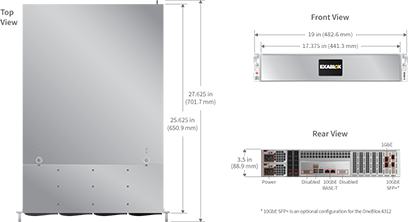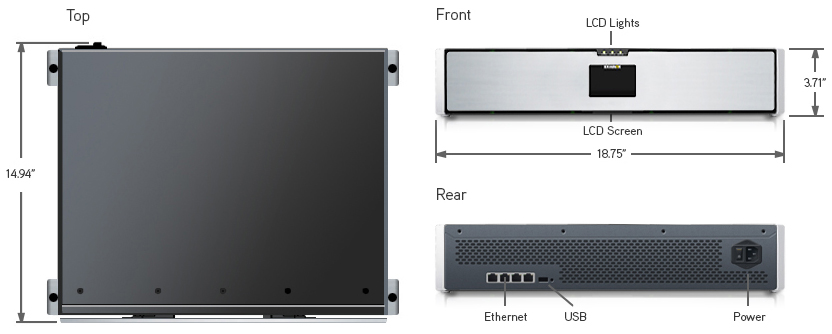
Exablox OneBlox Appliance
Scale-out NAS Built on Revolutionary Object-based Storage
Exablox is now StorageCraft. Please visit our StorageCraft site for the latest StorageCraft's products
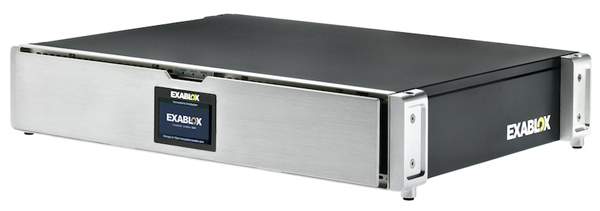
Our Price: $11,995.00
Our Price: $12,995.00
Click here to jump to more pricing!
Overview:
Exablox is reimagining storage with OneBlox, the industry’s first scale-out object-based appliance that is accessible with NFS and SMB network protocols for organizations of all sizes. Now, companies can utilize this affordable cloud-managed solution with leading edge enterprise features, including inline deduplication, compression, continuous data protection and zero-configuration storage expansion.
Exablox’s patent pending architecture solves businesses’ common storage pain points: complicated installation, cumbersome storage management, lack of data security and forklift upgrades. Without the shackles of a legacy storage architecture, Exablox’s clean-sheet approach combines the OneBlox appliance with OneSystem, an elegant multi-tenant cloud-based management service.
Highlights
- Powerful: The scale-out object-based file system enables non-disruptive capacity and performance expansion with zero configuration. Additionally, its inline deduplication and compression for primary storage and disk-based backup maximizes storage utilization without impacting performance.
- Simple: The secure multi-tenant cloudbased management service enables organizations and managed service providers (MSPs) to manage Exablox storage deployments with minimal effort from anywhere with an Internet connection, and eliminates on-premises software requirements.
- Protected: The always-on continuous data protection (CDP) capability, that can be defined on per share basis, enables fine-grained data recovery. Its real-time replication enables protection against multiple drive failures and disaster recovery.
OneBlox is a reimagined scale-out storage solution that any organization can afford.
Exablox’s cloud managed, scale-out, object-based storage appliance solves businesses’ common storage pain points: complicated installation, cumbersome storage management, lack of data security and forklift upgrades. Without the shackles of a legacy storage architecture, Exablox’s clean sheet approach combines the CIFS/SMB accessible OneBlox appliance with OneSystem, an elegant multi-tenant cloud-based management service.
Scale-out NAS on the Outside. Object Store on the Inside.
Exablox is the only scale-out file storage available for your Windows file shares, archival and backup data. The multi-purpose solution delivers pay-as-you-grow scalability and powerful storage features in an affordable package.

Power Meets Simplicity. At a Fraction of the Cost.
- Stop paying $1,000’s per TB for commodity disks
- Protect your data with Continuous Data Protection and Encryption
- Stop budget leaks from fork-lift upgrades
- Scale one disk or one appliance at a time - any time
- Setup disaster recovery with real-time replication in 4 clicks
- Simplify storage tasks with cloud-based management
- Reduce your storage footprint with deduplication
Features & Benefits:
Scale-out Architecture
OneBlox employs a seamless scale-out Ring architecture supporting multiple OneBlox appliances presenting a single global file system. A Ring may consist of one or multiple OneBlox, scaling from a few TBs to nearly 700TBs of raw storage capacity. As business storage requirements change, OneBlox is extremely agile; simply add any number of disk drives, at any time, and in any capacity granularity to meet your storage requirements. OneBlox simply grows the global file system with zero configuration and no application downtime.
Scale-out Storage for Virtual Environments
OneBlox uniquely supports VMware environments by enabling virtual machines to utilize scale-out NFS datastores. Consolidate multiple NFS datastores in a single OneBlox Ring and scale to multiple PBs with OneBlox’ advanced data reduction. Gone are the days of limiting a datastore to a few TBs with legacy RAID solutions as OneBlox’s object-based architecture removes any capacity limitation of datastores. Need more capacity? Simply scale-out OneBlox by adding drives or OneBlox and VMware instantly sees more storage capacity--with zero configuration.
Dynamic Reduction
Exablox is the only vendor in the storage industry enabling organizations to select between inline variable-length and fixed-length deduplication. Variable-length deduplication is perfectly suited for backup/recovery applications and yields exceptionally high deduplication ratios, typically, 10:1* or more. In addition, OneBlox's unique architecture enables inline compression and continuous data protection as well. Within a single Ring, OneBlox’s effective storage capacity scales in excess of 4PBs.
*Actual dedupe ratios will vary and results are based on each customer dataDynamic Growth
Bring your own drives. No RAID, no LUNs, no volumes. OneBlox delivers the flexibility for organizations to mix-and-match drive types (SATA, SAS) and capacity (1-8TB) within the same OneBlox and within a OneBlox Ring. Purchase exactly the capacity your organization needs at the beginning and then at any time in the future, increase capacity by mixing and matching any number of additional drives. In two minutes and zero configuration, OneBlox automatically pools the new storage within the existing global file system. No disruption to applications or users. No configuration settings to complete. No mouse clicks. No command line entries. No storage PhD required. Combined with OneBlox’s powerful inline deduplication and compression, storage waste is minimized and organizations are able to maximize primary storage utilization.
Agile and Affordable
OneBlox’s agility to add storage at any time comes with the additional benefit of delivering significant cost savings. Exablox’s bring your own drive philosophy treats commodity disk drives as commodities. Accordingly, every organization can purchase drives at retail prices and use up to 8TB drives within OneBlox. Gartner Group’s research indicates disk drives can account for up to 50% of the storage systems hardware costs. Avoiding the 5-10x markup from legacy storage vendors quickly results in a 10x cost savings compared to other storage solutions.
Zero Configuration
OneBlox can be installed and available to users in less than five minutes with zero configuration. Simply insert at least three drives, plug in Ethernet, power, and turn it on. It’s that easy. Need to add more storage? Simply add drives and the capacity is added to the same global namespace. Need to add availability or performance? With no interruption to applications or users, additional OneBlox nodes can be added and automatically configured, enabling organizations non-disruptive scalability with their business.
Data Protection
OneBlox’s continuous data protection ensures that all of the information written is fully protected. By taking continuous and unlimited snapshots of information written to OneBlox, every file can be easily recovered in the event of data corruption, deletion, or information held by rasomware. In fact, end users can recover their own information, simply by selecting ‘Previous Version’ from their PC or navigating Mac Finder or Windows Explorer. No need to restore information from last night’s backup, simply browse and recover in seconds.
Always on information
With its real-time replication, information stored in a OneBlox Ring is fully protected. By avoiding legacy RAID technologies, OneBlox is able to transparently replicate and redistribute the data across multiple drives and OneBlox to protect against two drive or OneBlox failures. Additionally, with its advanced architecture, information is protected against an entire Ring failure when replication over wide-area distances is implemented. OneBlox grows with your business’ data protection requirements without requiring costly downtime, reconfiguration, or forklift upgrades.
OneSystem Features & Benefits:
Cloud-based Management
OneSystem is a secure cloud-based management platform that proactively monitors, reports, and manages OneBlox in any location and from any browser. Eliminating the need for dedicated servers and time consuming software upgrades, simply login and gain the necessary insight into your storage infrastructure. Whether you have responsibility for a single location or multiple locations, OneSystem’s administration capabilities empower you to manage the entire storage infrastructure. Simply and securely.
Global Multi-tenant Architecture
OneSystem multi-tenant architecture was designed from the beginning and at its core to support every Exablox customer, regardless of geographic location. Consequently, OneSystem enables partners, managed service providers, and large enterprises to securely manage multiple discrete organizations’ information. As OneBlox is deployed on-premises, the information is closest to the application for performance, and storage management is cloud-based for scalability--from any browser-- anywhere.
Real-time Storage & Health Monitoring
Rest easy, Exablox is continuously monitoring the health and status of OneBlox. Exablox receives real time updates about OneBlox hardware, software, network connectivity….all the information critical to support organizations’ applications.
World-class Proactive Support
Exablox support is always keeping a watchful eye over every OneBlox deployment. Constantly monitoring and rapidly solving storage challenges, we often identify challenges before customers realize it. By proactively resolving issues, any application disruption is rapidly addressed.
Global Reporting
The best storage management decisions are based on information. OneSystem provides organizations with a global view into their storage infrastructure for reporting and trending of storage capacity, data reduction ratios, remote replication, and recovery point objectives.
Private OneSystem
Private OneSystem is the first hybrid solution offering an on-premises OneBlox storage management solution that is deployed as a virtual machine within a customer’s data center while leveraging the same proactive cloud-based monitoring and proactive support capabilities.
Specifications:
| OneBlox Appliance Specifications / Comparison | ||
|---|---|---|
| OneBlox 4312 | OneBlox 3308 | |
| Power | 100-240 VAC, 10.7 – 4.2A max | 100-120 / 200-240 VAC |
| Thermal Rating | 900 BTU/hr, 270W (typical) | 500 Btu/hr, 100W (typical) |
| Weight (empty, no disks) | 52 lb. (23.6 kg) | 23 lb. (10 kg) |
| Space Requirements | 17.2" w x 3.5" h x 25.5" d inches (37 x 89 x 648 mm) 2 Rack Units (RU) |
18.75" w x 3.7" h x 15" d inches (unit can fit in 19" rack or on table top) 2 Rack Units |
| Hard Drive Bays | 12 x 3.5” drive slots, hot swappable. 2 x 2.5” drive slots | 8 drive slots, hot swappable |
| Hard Drive Types | 3.5" SATA II & III (3 Gb/s and 6 Gb/s) 3.5" SAS (6Gb/s and 12 Gb/s) |
3.5" SATA (up to 6Gb/sec) 3.5" SAS (up to 12Gb/sec) |
| Max. Raw Capacity | 96 TB (12 disks rated at 8 TB each) | 48 TB (8 disks rated at 6 TB each) |
| Operating Temperature and Elevation | 10° C to 35° C (50° F to 95° F) | 10° C to 40° C (50° F to 104° F); at </= 3,000 m(at </= 10,000') elevation |
| Relative Humidity | 8% to 90% relative humidity, noncondensing | 20% to 80% relative humidity, noncondensing (28° C wet bulb temperature) |
| Non-operating Temperature and Relative Humidity | -40° C to 60° C (-40° F to 140° F); 5% to 95% relative humidity, noncondensing | -40° C to 65° C (-40° F to 149° F); 10% to 95% relative humidity, noncondensing, in original container |
| Operating Acoustic Noise | 56.5 dBA sound pressure (LpA) @ normal operating conditions (at 22°C and at sea level) | 56.5 dBA sound pressure (LpA) @ normal operating conditions (at 22°C and at sea level) |
| Cooling | Three adjusted fan cooled | Adjusted fan cooled |
| File Service Protocols | SMB (1.0, 2.0, 2.1, 3.0); NFS v3 | SMB (1.0, 2.0, 2.1, 3.0), NFS v3 |
| Onboard GbE Ports | 2 x 10GbE BASE-T, 2 x 1 GbE BASE-T, 2 x 10GbE SFP+ (optional) | 4 |
| Onboard USB Ports | 2 x USB 2.0, 2 x USB 3.0 | 2 |
| LCD Screen | (Virtual) Accessible through web browser | 3" TFT |
| LED Lights | Blue and red activity and status LEDs on each drive bay door | 3 lights on front panel for system status 8 drive status lights |
| Electromagnetic Emissions and Compatibility | FCC Class A, EN 55022 Class A, EN 61000-3-2/-3- 3, CISPR 22 Class A | FCC Part15B Class A (US), ICES-003 Class A (Canada) |
| Safety and Quality | CE Marking (Europe) | UL/CUL 60950 I.T.E. (US & Canada), Manufactured under an ISO 9001 registered quality system |
Solutions:
When it comes to the increasingly complex task of managing data storage, many small and midsize organizations face even greater challenges than large, global enterprises due to relentless growth in business information that needs to be managed and secured. In a recent survey by Storage Magazine, about one-fourth of the respondents pegged their unstructured file growth at 50% or higher year-over-year.
The consumerization of IT with fading boundaries between personal and workplace computing along with the unstoppable march to a virtualized IT infrastructure is pushing IT personnel to find new ways to manage their storage infrastructure. Some of their biggest hurdles are:
- Scaling storage as the business grows rapidly
- Containing the rising expense of data storage capacity
- Dealing with the complexity of storage management and architecture
- Devoting precious staff time efficiently to manage storage and data backup
With data volumes growing faster than anticipated, legacy scale-up storage architecture with two controllers sharing the workload and providing failover just doesn't stack up today. In a scale-up storage architecture, disks and shelves are added to expand capacity, only memory may be added to scale performance. Eventually, and o"en rather quickly, a scalability limit is reached, and the only available options are to either add another storage system or do a forkli" upgrade and replace the existing system. The consequences are sprawling storage silos that are complicated to manage with no investment protection that ultimately leads to spiraling costs.
In addition, small and midsize organizations that are looking to implement storage solutions with enterprise-class features to meet their business needs face complicated installation and management challenges. And in most cases, they are not equipped to handle these difficulties due to IT resource constraints and a lack of appropriate in-house expertise.
Fortunately, there are new approaches to storage on the market for growing organizations that can help address their storage needs without requiring dedicated management resources while at the same time driving down their costs.
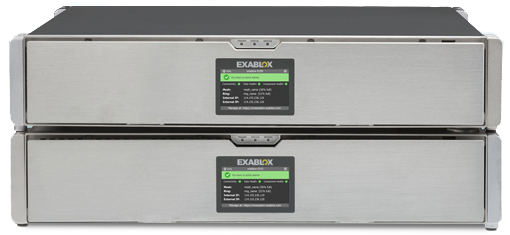
A New and Effective Approach to Storage
Exablox has designed a unique storage solution from the ground-up for small and midsize enterprises to help address their escalating data storage needs and deal with runaway storage costs and information management nightmares. Exablox offers OneBlox, a scale-out storage solution that is an on-premises hardware appliance combined with OneSystem, an integrated, enterprise-grade cloud-based storage management service.
OneBlox is a purpose-built appliance with all enterprise-grade features built-in such as continuous data protection, inline deduplication, encryption and disaster recovery and is completely automated for the IT personnel to setup and operate. The unique scale-out, converged storage appliance consolidates primary data as well as the backup and archival data.
Eliminate Complexity
 OneBlox is plug and play scale-out storage with the ability to "bring your own disks" to the appliance – paying retail pricing rather than a 2-5X vendor premium. OneBlox provides additional flexibility by allowing users to mix-and-match drive types (SSD, SAS, SATA) and capacity within the same OneBlox and within a ring with zero-configuration. Drives can be removed, recycled, reused, and replaced dynamically while the file system restores the desired levels of data protection automatically through object-based replication.
OneBlox is plug and play scale-out storage with the ability to "bring your own disks" to the appliance – paying retail pricing rather than a 2-5X vendor premium. OneBlox provides additional flexibility by allowing users to mix-and-match drive types (SSD, SAS, SATA) and capacity within the same OneBlox and within a ring with zero-configuration. Drives can be removed, recycled, reused, and replaced dynamically while the file system restores the desired levels of data protection automatically through object-based replication.
The engine that drives OneBlox storage appliance is a distributed object-based file system, which provides ubiquitous data access by presenting a CIFS/SMB file share to users and applications. Object level replication protects data from disk or node failures while eliminating the need for legacy RAID protection schemes. Provisioning is instantaneous since there is no RAID, volume or LUNs to configure. Data replication is in real time and by default, in triplicate. If there is more than one node in the local cluster called a "ring", it ensures that at least one of the replicates is on a different node. Failed disks (or nodes) can simply be removed and replaced with no disruption to data services to the application and users — OneBlox will dynamically rereplicate all the objects on the node as needed to maintain the appropriate protection level. There are no vulnerable or offline rebuild windows as with legacy RAID approaches and no worrying about LUNs or volume sizes.
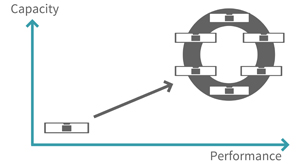
Scale Effortlessly
Multiple OneBlox appliances can be aggregated (currently, up to 6) into a single clustered ring by simply powering them up on the same LAN. They automatically discover the other OneBlox appliances and join the ring with zero-configuration. Once nodes are clustered, not only does OneBlox automatically redistribute any data objects across the ring, it presents all the aggregated storage capacity in the same global namespace. When either a disk or a new node is added, the current network share expands automatically and nondisruptively to include the new capacity. There is no need to manually manage storage pools, RAID sets, manage volumes or migrate data to consume the increased capacity.

Optimized Storage Capacity
OneBlox includes inline data de-duplication to dramatically improve storage utilization that helps lower costs. It applies de-duplication for all written data with no questions to answer, no radio buttons to click and no management. The de-duplication is performed across the entire ring or global namespace, which significantly reduces the total storage space required.
No-Compromise Data Availability
 In addition to the ring level replication, OneBlox provides advanced continuous data protection in the form of automatic snapshots that occur for every file write. At any point, an immediate online recovery of previous versions of a file can be achieved without timeconsuming restoration from backups. Users can easily find and recover files themselves by navigating through a dedicated "Snapshots" folder through Mac Finder or Windows Explorer. The snapshots are de-duplicated against the primary data to keep the storage requirements low, are directly accessible and cannot be modified.
In addition to the ring level replication, OneBlox provides advanced continuous data protection in the form of automatic snapshots that occur for every file write. At any point, an immediate online recovery of previous versions of a file can be achieved without timeconsuming restoration from backups. Users can easily find and recover files themselves by navigating through a dedicated "Snapshots" folder through Mac Finder or Windows Explorer. The snapshots are de-duplicated against the primary data to keep the storage requirements low, are directly accessible and cannot be modified.
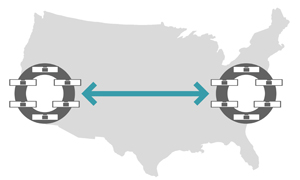 OneBlox not only protects against file deletion/ corruption, but also drive removal. Every object that is written to OneBlox is encrypted (in-line) with AES 256 before it's written to the physical disk. Failed or obsolete drives are unreadable and can be simply removed and discarded. Following the OneBlox core design principle, encryption happens automatically — there is no special configuration to setup.
OneBlox not only protects against file deletion/ corruption, but also drive removal. Every object that is written to OneBlox is encrypted (in-line) with AES 256 before it's written to the physical disk. Failed or obsolete drives are unreadable and can be simply removed and discarded. Following the OneBlox core design principle, encryption happens automatically — there is no special configuration to setup.
Exablox also offers cost-efficient, real-time, cross-site replication for disaster recovery to protect against failure of an entire ring or site. Both the rings continue to share the same global namespace giving users and applications in both locations access to information in its entirety. Since the data is already de-duplicated and encrypted with only incremental changed objects needing remote replication, WAN usage is optimized while the information continues to be secure. Remote replication across rings can also be used to distribute data across sites and support ROBO locations.
Simple Storage Management
Exablox provides OneSystem – an innovative, multitenant, cloud-based management service – that eliminates the need for dedicated servers and so"ware on the customer premises to manage storage. OneSystem allows for ubiquitous accessibility and simplified storage management workflow. With OneSystem, there is no need to install local storage tools or configure VPNs for remote management access.
 OneBlox administrators simply log into OneSystem from any browser and manage their onpremises OneBlox systems. Management workflow is visual, point-and-click, drag-and-drop and directly actionable. An intuitive browser interface is used to configure new shares, users, groups, integration with Active Directory, and setting up disaster recovery. OneSystem proactively tracks and monitors the usage, capacity and health, and issues alerts if necessary.
OneBlox administrators simply log into OneSystem from any browser and manage their onpremises OneBlox systems. Management workflow is visual, point-and-click, drag-and-drop and directly actionable. An intuitive browser interface is used to configure new shares, users, groups, integration with Active Directory, and setting up disaster recovery. OneSystem proactively tracks and monitors the usage, capacity and health, and issues alerts if necessary.
Increase Flexibility
According to Forrester, one of the greatest culprits behind data growth is actually disk-based backup data. Between 2010 and 2012, the average enterprise server backup data store grew by 42%, archival data grew by 45%. With more and more mobile workers, PC backup storage is also growing at an explosive rate, almost 100% over the past two years. To contain this spiraling backup and archival costs, Forrester advises the IT organizations to look for following key criteria in their storage systems:
Data reduction capability
- Encryption
- Continuous data protection
- Ease of setup and implementation
- Ease of on-going management
The Exablox storage solution unquestionably delivers on all of these metrics:
- Inline de-duplication keeps the effective capacity growth in check
- Scale-out capability helps to grow capacity dynamically as the data grows
- Encryption and continuous data protection safeguards the "last-resort" data, and
- The solution has been designed from ground-up for simplified management workflow
In fact, it can consolidate both the primary/ production file data as well as the backup/ archive data within a single cluster depending on the organizational needs. The continuous data protection capability eliminates the need for frequent full-backups of the data stored on the OneBlox ring. The inline-deduplication helps keep the storage footprint in check when using the OneBlox ring as a target for backup/ archive of the production data from the existing storage systems in the environment.
OneBlox and OneSystem Technical:
The Business Challenge
Some estimates indicate that, in 2012, 2.5 quintillion bytes of data was generated globally – that's two billion terabytes. Every day, that rate of generation increases as more and more people store more and more data in new and different ways. Enterprises have been forced to continue to "throw hardware" at this storage problem in order to maintain the rates of capacity growth. As a result, many enterprises are supported by storage platforms that might better be called "Frankenstorage." Moreover, the foundational storage arrays used by these enterprises is likely not as scalable and feature-rich as necessary for them to be fully reliant on these systems.
In short, traditional storage systems do not provide the breadth and depth of functionality that modern enterprises demand. But, that's only a part of the equation.
Storage Technology has Fallen Behind
It's easy to see that traditional storage technology has fallen woefully behind what is required in the modern enterprise. In so many ways, storage actively works against an organization, requiring constant attention, expensive consultants, and specialized third party monitoring tools. Some storage systems look much like a car with no tires, no dashboard, and a square steering wheel. Sure, it would be possible to drive on the rims, but it would be a poor driving experience and, without the dashboard, it would be impossible to figure out how fast the car is driving.
Data Management has Become Increasingly Difficult
Besides the very real problem of ongoing capacity upgrade needs, enterprises also face a multitude of challenges around ongoing management of the data and of the very systems that house the data. While traditional storage vendors have attempted to bring ease of use and ease of administration to their products, they are saddled with the burdens of legacy architectures that practically force complexity into the administrative process. As such, storage management has become a specialized niche for many IT staffers that are tasked with maintaining an organization's storage assets. The problem here is that every minute that a storage administrator has to spend on unnecessary tasks is a minute delay in getting a product to market or a minute lost in focusing on business-facing organizational goals.
What Would Perfect Storage and Storage Management Look Like?
In a modern enterprise, storage is the lynchpin upon which all services depend. Employees and customers alike are affected by the storage choices that are made. Because of this and after studying the major storage challenges that affect enterprises, Exablox decided to ask a very simple question: "What would the perfect storage system and storage management look like?" It's a short question, but with a number of different answers. At the same time, we scanned the storage market and realized that there can be many correct answers but no one has brought together what we feel is the perfect solution... until now. Exablox has cherry-picked the best features from best of breed solutions across the storage landscape and brought them into a single product.
Exablox will:
- Scale-out seamlessly to accommodate capacity, performance, and/or availability requirements
- Deduplicate information to maximize storage utilization
- Snapshot information to provide granular file level recovery
- Fail over and replicate resources enabling continuous information availability
On the management front, Exablox also identified the cream of the crop with regard to how certain products are managed and envisioned and built a storage management system that has the following characteristics:
- Be intuitive and easy to use
- Configure and integrate with cloud-based services
- Proactively diagnose and report problems
- Strive for zero configuration for storage management tasks
The end result of this effort is a powerful, yet simple, storage management appliance, OneBlox, coupled with a cloud-based management service, OneSystem. In fact, the OneBlox and OneSystem combination is so intuitive that a typical IT staff person can have the initial node up and running in just 5 minutes.
But that simplicity doesn't come by way of a scaled-back product. The Exablox solution is incredibly powerful and feature-filled, as you will discover in the rest of this paper.
The Exablox Ecosystem and Components
In order to achieve the lofty goals set forth for this new vision of storage, Exablox has built, from the ground up, a brand new and unique storage ecosystem. Exablox provides organizations with massively scalable storage with enterprise-class features and single-instance cloud management that brings the entire environment under a single administrative umbrella, regardless of how large it ultimately grows.
Exablox takes a building block approach to architecture, starting with a node, expanding to a ring, and eventually becoming a mesh. Each object type is described in the following sections.
OneBlox Appliance
 A OneBlox appliance is a single hardware device intended to store a company's data. OneBlox is a 2U appliance provides eight hot swappable 3.5" hard drive slots and supports up to 32 TB of raw capacity when each slot is mixed outfitted with 4 TB drives. As 6TB drives become available, OneBlox will immediately support 48TB configurations. In order to meet the unique performance goals across a variety of customers, the OneBlox appliance supports the use of SATA and SAS disk drives and drive capacities can be within a given OneBlox. A OneBlox array exposes administrator-managed shares through the Common Internet File System (CFIS)/Server Message Block (SMB) protocol and appears on the network as a Network Attached Storage (NAS) device.
A OneBlox appliance is a single hardware device intended to store a company's data. OneBlox is a 2U appliance provides eight hot swappable 3.5" hard drive slots and supports up to 32 TB of raw capacity when each slot is mixed outfitted with 4 TB drives. As 6TB drives become available, OneBlox will immediately support 48TB configurations. In order to meet the unique performance goals across a variety of customers, the OneBlox appliance supports the use of SATA and SAS disk drives and drive capacities can be within a given OneBlox. A OneBlox array exposes administrator-managed shares through the Common Internet File System (CFIS)/Server Message Block (SMB) protocol and appears on the network as a Network Attached Storage (NAS) device.
Each OneBlox appliance connects to the network with four gigabit Ethernet (GbE) ports, all found on the back of the device. In addition, administrators enjoy at-a-glance operating information thanks to the 3 inch LCD screen found on the front of each appliance and the LED lights that provide immediate appliance diagnostic details.
With the OneBlox appliance, customers can start small and grow as the need arises. Start with just a few hard drives and add more as capacity needs increase or simply swap a small capacity hard drive for a larger one in the array, all with no downtime and zero-configuration. This is the basic way that the OneBlox system easily scales to meet growing customer needs, but without the complexity that accompanies traditional storage systems.
Rings
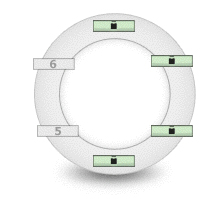 Scalability is in the Exablox DNA. With a single appliance, customers can grow to support up to 48 TB of storage. But it doesn't stop there. Customers can connect up to six OneBlox appliances together to form a ring, which presents a single file system to applications and to users. In other words, this six-node cluster appears as a single 288 TB global file system and the whole system is still managed through a single OneSystem account, as discussed later. As new appliances are added to a ring, behind-the-scenes data protection technology kicks in to automatically spread data among the various nodes in order best to protect the environment in the event of a hardware failure. This data protection technology works through replication, with three copies of all data stored in various locations in the ring. As such, the maximum usable capacity in a ring is 96 TB and without taking into account any inline deduplication--which will increase the usable capacity.
Scalability is in the Exablox DNA. With a single appliance, customers can grow to support up to 48 TB of storage. But it doesn't stop there. Customers can connect up to six OneBlox appliances together to form a ring, which presents a single file system to applications and to users. In other words, this six-node cluster appears as a single 288 TB global file system and the whole system is still managed through a single OneSystem account, as discussed later. As new appliances are added to a ring, behind-the-scenes data protection technology kicks in to automatically spread data among the various nodes in order best to protect the environment in the event of a hardware failure. This data protection technology works through replication, with three copies of all data stored in various locations in the ring. As such, the maximum usable capacity in a ring is 96 TB and without taking into account any inline deduplication--which will increase the usable capacity.
Mesh
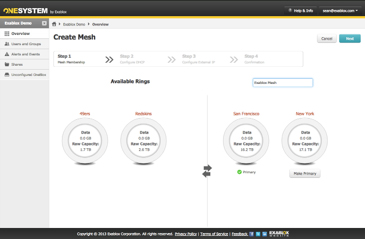 Capacity and scalability are critical to many organizations. But without comprehensive data protection, a storage system can't be considered "simple" and "easy to use" since administrators will need to make significant investments of time and expense in separate technologies to provide data protection. Through the use of a mesh configuration, customers can create collections of two or more rings that are automatically mirrored or replicated to one another, all behind the scenes.
Capacity and scalability are critical to many organizations. But without comprehensive data protection, a storage system can't be considered "simple" and "easy to use" since administrators will need to make significant investments of time and expense in separate technologies to provide data protection. Through the use of a mesh configuration, customers can create collections of two or more rings that are automatically mirrored or replicated to one another, all behind the scenes.
Lest anyone think that replication has to be a difficult service to implement, it's important to note that the OneBlox mesh is created through a simple, intuitive, GUI-based drag and drop process akin to moving a file from one folder to another in an operating system. It's simply done in 3 steps and 3 minutes.
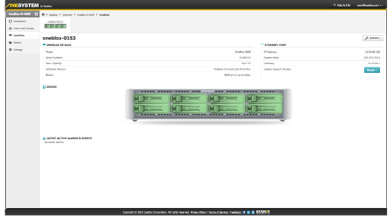 OneSystem
OneSystem
If the hardware Exablox is bringing to bear seems impressive, the software suite behind it – called OneSystem – is nothing short of magical. Instead of relying on the traditional storage management paradigm, the entire OneBlox ecosystem – the appliance, rings, and meshes – are managed from a central, cloud-based management service. No matter where customers are, they are able to access the web-based OneSystem, shown in the Figure below.
Besides being eminently accessible, OneSystem is also simple and intuitive, from initial storage configuration to ongoing management. By putting pertinent information right in front of the administrator, there's no digging through screens and screens of information in an attempt to figure out how much space is left in the environment and whether or not there are any alarms that require resolution.
OneSystem can also seamlessly integrate with an on-premises Active Directory (AD) environment in order to provide users and groups to the management environment. This allows an administrator to leverage existing assets, which further simplifies the administrative experience.
Inspired by the simplicity of a Bluetooth-style pairing, OneBlox with the OneSystem management is a snap. When a new OneBlox appliance is deployed, it connects to OneSystem to announce its availability. From there, an administrator logs in to OneSystem and, using details that helpfully appear on the OneBlox LCD display, pairs the appliance with OneSystem. The entire process takes mere minutes and once accomplished, the full administrative experience becomes available to the administrator. The use of both a username and password to log in to OneSystem and a unique pairing code provides multifactor security to keep the right hands on the data.
To maintain as much ease of use as possible, all of OneBlox features are enabled and configured by default and do not present individual configuration parameters.
Distributed Object-based File System
To achieve the stated goals of the OneBlox system, Exablox has created a groundbreaking new file system. OneBlox's object-based file system handles all aspects of data storage and protection, including protecting all storage in a number of ways. OneBlox protects against:
- Data deletion or corruption
- Drive removal
- Drive failure
- Appliance failure
- Ring failure
Simple doesn't mean ordinary! Exablox's vision required the design and implementation of many enterprise- class storage features architected to be as powerful as those features found in traditional storage systems, but with exposure to the administrator that retains the desire to provide an easy-to-use solution. As such, significant engineering has gone into building world-class features for organizations more interested in solving business problems than in fighting with storage. OneBlox's file system is built on top of a distributed content addressable content store. As new data goes into the file system, they are chunked up into 32KB blocks and distributed around the ring. Once distributed, additional replicas are created for data protection. Clients accessing content stored in a ring are load balanced across multiple nodes, which increases performance and reliability of the storage environment.
To maintain performance levels that are necessary for large amounts of data, each node maintains its object metadata in an index stored on a solid state disk (SSD) which is built into each OneBlox.
The Global Namespace
The Global Namespace is the single presentation of the OneBlox environment to the user base and is the file system that powers OneBlox. With the OneBlox file system, administrators do not create traditional storage objects such as LUNs, volumes and aggregates. Nor does the OneBlox system use RAID for data protection. As storage capacities have grown, RAID has proven to be the Achilles' Heel for many, as rebuild times in the event of a disk failure grow longer, increasing the potential for data loss.
Instead, OneBlox uses a comprehensive replication engine and other features, including Continuous Data Protection (CDP), to protect data and to present to users a single, unified view of the storage environment.
Local Replication
The cornerstone for many enterprise data protection efforts, replication is a key asset in the Exablox arsenal and is used throughout the ecosystem, from single appliances all the way up interconnected meshes. In fact, data protection is so critical in the Exablox vision that, by design, multiple copies of data are always kept, but the exact process depends on how many OneBlox nodes and Rings exist in the environment:
- Single node. OneBlox creates three replicated copies of the information on the single node across 3 drives, which enables the loss of up to two physical hard drives in the appliance, without loss of data.
- Two nodes in a ring. OneBlox load balances and distributes three copies of information across both nodes and across ensures each copy is on 3 separate drives. In this scenario, an entire node can fail and users will still have access to their information.
- Three or more nodes in a ring. OneBlox leverages all nodes in the ring as replication targets, enabling a scenario in which two nodes can fail and users will still have access to their information.
Deduplication and Compression
Data protection always comes with some kind of cost. When data is replicated, as is the case with OneBlox, additional capacity is required to store that replicated data. However, to maximize the overall usable capacity of a OneBlox appliance or ring, Exablox has imbued the system with powerful inline data deduplication. Each time a file or portion of a file is targeted to the OneBlox system, it checks to see if that data already exists in the environment. If it does, that second copy is simply discarded and a very small pointer to the original copy of the file is put into that space instead, which uses just a fraction of the storage that would otherwise be used.To put it simply, each time data is written to the environment, OneBlox asks a simple question: Do I need to store the data or just create a pointer?
In a traditional storage environment, deduplication is often disabled and not used for primary storage due to the processing overhead that is introduced inside these legacy environments. With OneBlox, not only is deduplication enabled by default, it can't be disabled. The OneBlox system has plenty of processing power.
Continuous Data Protection Through Snapshots
Although fast disk-based technologies have been available for many years, many companies will rely on backup windows to keep long-term archives of their critical business data. Most often, these backup windows take place over night. This presents a significant opportunity for data loss in the organization if, for example, a data loss event takes place at the end of a workday. In this case, all of the work performed since the most recent backup – which took place in the wee hours of the morning – is lost.OneBlox provides a powerful data recovery feature known as Continuous Data Protection (CDP). Throughout the day, OneBlox continuously takes snapshots of new data written in the system and keeps those snapshots as recovery points in the event of data loss, which could be something as simple as an accidentally deleted file. This snapshot-based approach to Continuous Data Protection eliminates the data loss window, enabling much faster recovery in the event of a serious data loss issue.
It might seem that the snapshots feature could use massive amounts of disk space. Thanks to OneBlox's deduplication engine, snapshots use only a fraction of the space that they otherwise would, enabling very granular data recovery at a minuscule cost.
In a "keeping IT focused on the business" feature, these snapshots are actually available to users who can access them through Windows Explorer or the Mac Finder and recover older versions of their own files without IT having to be involved. OneBlox provides the ability to go back to the last file written (which could be the last second), as well as further back in time: the last minute, hour, day, week, month, or year(s).
As is the case for deduplication, continuous data protection is enabled by default and cannot be disabled.
Encryption
No matter how big the business, data security is of prime importance but is something that business owners don't want to have to worry about. However, inattention to security can bring negative PR in the event of a data breach due to unsecured data. By default, with OneBlox, data is always encrypted while it is stored in the system and this encryption cannot be disabled. This atrest encryption system uses AES 256 to protect even the most sensitive information.Thanks to this encryption technology, organizations deploying OneBlox can rest assured that a lost or stolen hard drive can't be used to steal sensitive information. In fact, the encryption allows an organization to simply throw away bad hard drives without having to worry about the contents ultimately being retrieved by data thieves.
CIFS/SMB
The Microsoft Windows-standard CIFS/SMB file server protocol has been around for a long time and enjoys wide operating system support. As such, OneBlox exposes file shares via the Global Namespace using SMB. This enables immediate access to OneBlox shares from Windows-, Linux-, and Mac-based systems in the organization.Additionally, OneBlox provides OneSystem with the ability for administrators to authenticate with Active Directory environments so that existing user accounts can be used for OneBlox access. This negates the need to maintain a separate user directory in OneSystem if users are elect to use Active Directory.
Remote Replication
Sometimes, disaster strikes. Mother Nature has a knack for attacking without warning and entire parts of cities can be wiped off the map. To protect against site failures such as this, many companies deploy disaster recovery sites that are physical separated from the main data center.For those concerned about potential site failure, a ring, which can consist of up to six interconnected OneBlox, may be replicated to another ring in what is known as a mesh. This replication feature replicates the information across the two rings and only replicates the changed deduplicated information on an ongoing basis. In the event of one site going offline, the other site has additional copies of the information and users can access the information from the alternate ring. OneBlox enables customers to build reliability and disaster recovery for a low price and without the complexity that often dooms these implementations. Moreover, all information replicated to each ring is already deduplicated and encrypted, so the network utilization is maximized.
Increasing Capacity
No company is a static entity. Organizations grow and change every day and this growth becomes a part of the organization culture. Why is it then that adding additional storage capacity with a traditional storage system is always an "event" that requires planned downtime and can carry with it the risk of an outage?There's a much better way to handle capacity increases. With zero configuration additional disk drives or OneBlox can be added in support of an organization's growth. With OneBlox, there are three primary ways to add capacity:
- Add new hard drives to an existing OneBlox
- Upgrade existing hard drives in an existing appliance with drives of a higher capacity
- Add new OneBlox to an existing ring
Adding or Upgrading Hard Drives
With traditional storage arrays, adding capacity often means buying a huge, expensive shelf fully populated with hard drives even if just a few TB of extra capacity is needed. With OneBlox, if an appliance has available hard drive slots, an administrator can simply insert a new hard disk until it clicks in place. That's it. It's a complete tool-less process and it doesn't matter what the capacity is of the new hard drive. OneSystem simply detects that a new drive has been added and works behind the scenes to integrate its capacity into the environment. Organizations can always use any hard drive purchased from a computer store. OneBlox inherently supports the latest drive technology.If a customer wishes to upgrade the capacity of an existing appliance, the existing hard drives can simply be replaced one-by-one with drives of a larger capacity. OneSystem and OneBlox will handle the integration of the new capacity and the redistribution of existing data on the appliance and in the ring. In either case when adding additional drives, it requires zero configuration. The additional capacity is dynamically pooled with the existing global file system and applications and users immediately have more capacity. With a traditional storage array, this drive-by-drive replacement process would be extremely tedious, and most likely not supported by the storage array vendor.
Adding OneBlox
As more capacity is needed in an environment, customers can simply add more OneBlox to an existing ring and scale capacity, performance, and availability. As new devices are deployed, they are automatically discovered by OneSystem and are seamlessly added to the storage environment. Similar to drive expansion, adding OneBlox to a ring requires zero configuration. From a user perspective, the effective storage capacity of the environment simply grows as new OneBlox are added. No changes to users or applications is required to take advantage of the additional capacity.Increasing Network Throughput
Although gigabit Ethernet is fast, sometimes it's not fast enough, particularly when dealing with dozens or hundreds of terabytes of data. In addition to scaling capacity, each OneBlox appliance has been gifted with the ability to scale to up to 4 Gbps of raw throughout thanks to the quartet of bonded gigabit Ethernet adapters that are built into the device. In the figure below, you can see these ports at the lower left hand side of the picture.
Summary
Exablox uses three words – Powerful, Simple, and Protected – to describe what is a top to bottom reinvention of how storage works at the most fundamental levels. By abandoning legacy RAID concepts and traditional scale-up storage architectures, Exablox has incorporated best of breed ideas into a single integrated solution and management experience. Exablox is enabling organizations to solve complex business challenges with powerful, yet simple and elegant, storage.
Video Demo:
In this demo, you'll see the benefits of continuous data protection and the power and simplicity of OneSystem, the cloud-based management for OneBlox. You'll also see how many of the storage management features, like growing a scale-out cluster require zero configuration.
Documentation:
Download the Exablox OneBlox 4312 Appliance Datasheet (PDF).
Download the Exablox Product Brief Datasheet (PDF).
Download the Exablox OneBlox and OneSystem Overview Datasheet (PDF).
- Pricing and product availability subject to change without notice.
Our Price: $11,995.00
Our Price: $12,995.00


